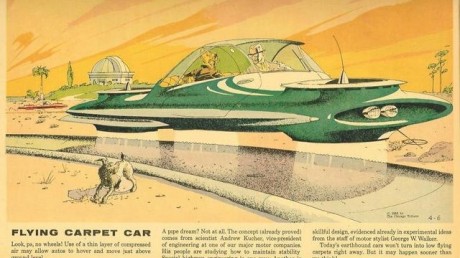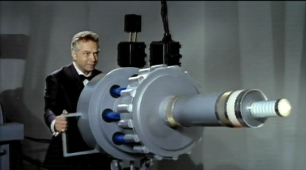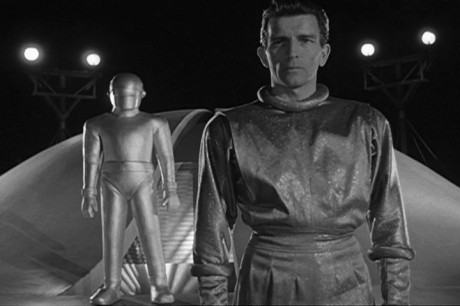Flying Cars, Death Rays & Killer Robots: Fact Checking The Future Promised By The 1950s
Wednesday, August 31st, 2011In the post World War II era the future seemed like a wonderful place full of atomic-powered wonders. A Future World unspoiled by pollution, radiation or flower children. Lets examine the promises and realities of that vision of the Past’s Future.
1) Flying Cars
It seems that every vision of the future had one of these ,a trend that even trancended the fifties all the way to modern sci-fi Films. An there was reason to hope. Even Ford got into the flying car designing bussiness.
The Promise:

The Reality:
Although we still have no flying cars in every garage, many pioneers and design firms are hard at work trying to make
this particular conceit of Science Fiction a reality. One of the most advanced endeavour comes from Moller International and it is called the Volantor. It is about to undergo extensive flight testing. Who knows in a few years, were we are going, we wont need “Roads.”
2) Death Rays
No futuristic vista would be complete without early vision of the Death Ray. Diorama, movies or science fiction literature the terrifying device was ubiquitous. Wielded by the good guy, or more likely, the evil alien invader. The future was going to be dominated burly men in tights toting these around.
The Promise:

The Reality:
Today lasers are in every conceivable human device. There are lasers in Blu Ray players and CD players. They are used to heal skin and even in communications. Chances are that you are watching this though an internet connection that relies on lasers as the main driver for fiber optics. And although you can take an industrial cutting laser and aim it at a person, it is far better to use it to precision cut glass or steel.

3) Killer Robots
The 40s and 50s image of The Future would not be complete without the helpful robot about to turn evil. The future would be a place where machines in the shape of men would run amok throught the coming centuries. From the epic RUR by Capek : “The product of the human brain has escaped the control of human hands.”
The Promise:

The Reality:
Robotics are one of modern societies greatest assets. Again, like the death ray (AKA laser) we have found ways to shape and use robots in all kinds of capacities from the lowly inkjet printer to the giant A380 passenger plane. They are all around us. Computer controlled mechanical devices perform all kinds of tasks mostly for the benefit of mankind. The build our cars and do our laundry and yes they even aid in the exploration of Space. Although one could argue that smartbombs and cruise missiles are indeed killer Robots, most perform quietly and wait for the right moment to strike. We’re on to you Roomba!
4) Space Travel
Perhaps the Personification of the future in the Atomic Age, space travel was everywhere. It was a promise that almost delivered. Take a look at my hero, Walt Disney, telling us what the future held back in 1952.
The Promise:
The Reality:
Although we now face an uncertain future in Space travel the past 50 years have been amazing and in many ways up to the standards of earlier generation’s expectations. Here is a reminder:
And there we have it. It seems that the world of tomorrow is indeed here. The problem is that it happened gradually. There are, of course, all manner of wonders that were never thought of by the visionaries of the Atomic Age. I only hope that we manage to escape the fears and we accomplish the aspirations of those who believed in The World of Tomorrow. Oh well, let me take my vacuum tube elevator to my garage on the roof. I have a Pan Am flight to catch to The Moon. Mustn’t Keep the Clavius Monolith waiting.






